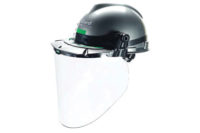This article discusses the exposure hazards to eyes/face associated with specific non-ionizing electromagnetic radiation (EMR) not addressed by OSHA: ultraviolet (UV), infrared (IR) and high-energy visible light (HEV).
Ultraviolet light
UV is found in sunlight and is a form of EMR with high frequency waves. The biological effects of UV radiation depend on the wavelengths concerned. The non-ionizing UV spectrum has a wavelength shorter than that of visible light but longer than an X-ray (100 nanometers [nm] to 400nm) and is categorized based on intensity: UV-A (315nm to 400nm), UV-B (280nm to 315nm) and UV-C (100 nm to 280nm).
UV-C generally dissipates in the atmosphere and seems to have little damaging effect. However, UV-A and UV-B have damaging effects on exposed soft tissues, such as skin and eyes. Exposure to UV accounts for 90 percent of the symptoms of premature skin aging. Similarly, radiation damage to the cornea can be caused by something as simple as the reflection of sunlight off of water or snow, or something occupationally specific such as a photographer’s flood lamp, a welding torch or an UV curing lamp. Cataracts, macular degeneration and photokeratitis (a feeling of sand in the eyes) can all be attributed to overexposure to UV light.
While OSHA does not have a specific standard regarding exposure to UV, several other sources provide exposure limit guidelines. These include: The National Institute for Occupational Safety and Health (NIOSH) and The American Conference of Governmental Industrial Hygienists (ACGIH), who have developed Threshold Limit Values (TLVs) considered by OSHA to be National Consensus.
Protection against UV may be achieved by a combination of engineering, administrative control measures and personal protective equipment (PPE). Always place emphasis on engineering and administrative controls (such as use of enclosures, screens or filters to contain the UV radiation; training; and limiting employees’ access and exposure), thus minimizing the need for PPE. After taking these steps, determine whether further protection for the face, eyes or skin is necessary, and if so, what type of PPE is needed. ANSI/ISEA Z87.1-2010 (the “Standard”) provides transmittance requirements for UV filters for personal devices for eye and face protection. A common misconception is that all polycarbonate lenses block UV. This is not the case. If UV filtration claims are made by a manufacturer, applicable UV filtration markings must be placed on the product.
Infrared
IR is found in many industrial settings including steel mills, textiles, paper and glass manufacturing, or where lasers, arc lamps or electric radiant heaters are used. IR waves are located between microwaves and visible light on the EMR spectrum. IR has a range of wavelengths, with near infrared being the closest in wavelength to visible light, and “far infrared” closer to the microwave region. Near infrared waves are short and not hot — in fact you cannot even feel them — which is what makes them particularly dangerous to susceptible tissues, such as skin and eyes.
Skin exposed to IR provides a warning mechanism against thermal effect in the form of pain. Eyes, on the other hand, may not. Since the eye cannot detect IR, blinking or closing the eyes to help prevent or reduce damage may not happen. IR, particularly IR-A or near IR [700nm-1400nm], raises the internal temperature of the eye, essentially “baking” it. Medical studies indicate that prolonged IR exposure can lead to lens, cornea and retina damage, including cataracts, corneal ulcers and retinal burns, respectively. To help protect against long-term IR exposure, workers can wear products with IR filters or reflective coatings.
The Standard provides requirements for welding and infrared filters, including exact product markings required for specific filtering claims. This makes the selection of appropriate PPE a bit easier for those trained in the use of TLVs, such as an industrial hygienist.
The Standard does not, however, provide requirements for IR reflectance. While the North American market offers reflective-coated products designed for use in elevated temperatures (ET), many times these are mistakenly used only to help prevent worker heat stress. Unfortunately, ET conditions also lend themselves for likely long-term IR exposure. Because there are no Standard requirements for IR reflectance, there is no way within the Standard to substantiate claims that such visors reflect IR. However, the European Standard (EN166, 7.3.3), offers an “R” mark to substantiate claims of “enhanced reflectance in the infrared.” An “R” mark on a visor signifies that the mean spectral reflectance of IR between 780nm–2000nm (i.e., the amount reflected from the protector) is >60%. So, it might be wise to check products for EN markings, as well as to request certification/test data for such claims for those products not marked with EN166 “R” marks.
High energy visible light (HEV)
High energy visible light (HEV) or “Blue Light,” as it is known, is visible light with wavelengths in the ~381nm to 500nm (adjacent to UV on the EMR spectrum). HEV is longer than UV, and high illumination levels have been shown to cause irreversible cell damage in some individuals. Extended exposure to HEV may increase the risk of macular degeneration disease where an affected person loses their central vision. Unfortunately, this condition slowly worsens and its damage is usually irreversible.
People are exposed to Blue Light naturally through computers, televisions and cell phones. Industrial uses include lasers and medical diagnostic equipment. A person who needs protection from Blue Light should secure a lens known as a “blue blocker.” Blue blockers usually have a base tint of yellow, but they come in darker orange shades as well. Generally, they don’t reduce light, but rather, alter the appearance of blue and green colors. Because Blue Light is so close in the spectrum to UV, it is recommended to use blue blockers that offer UV protection as well.
Although OSHA does not offer guidelines for the protection of UV, IR and HEV radiation, it is important to consult other sources for exposure limits and take preventative measures now, such as educating workers and providing appropriate PPE.
For more information on choosing proper face protection, visit www.MSAsafety.com.
Footnotes
Heather Brannon, MD, “Effects of Sun on the Skin: Cellular Skin Changes Caused by UV Radiation”, About.com Dermatology, March 23, 2007
2 Gary Heiting, OD, “Ultraviolet (UV) Radiation and Your Eyes”, All about Vision, July 2012.
3 An exposed person may blink if the IR is accompanied by a light flash of sufficient intensity
4 “Radiation Effects on the Eye, Part 1 – Infrared radiation effects on ocular tissue, Optometry Today, 1999.
5 Carol Dykas, L.O., ABOC, NCLC, “How to Protect Patients from Harmful Sun light,” 20/20 Magazine, June 2004





